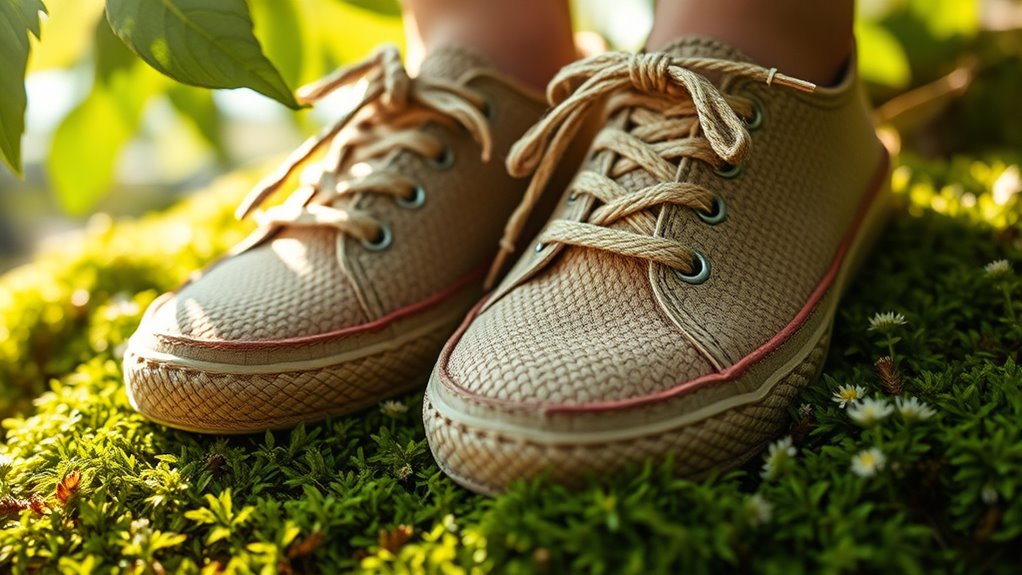Eco-friendly shoes use sustainable materials like organic cotton, hemp, bamboo, cork, and recycled plastics that reduce environmental impact. They are made with innovative techniques such as pattern optimization, 3D knitting, and biodegradable components to minimize waste. Designed for durability and timeless style, these shoes support your foot health and last longer. If you want to discover how these advancements shape future footwear, keep exploring what makes shoes truly eco-friendly.
Key Takeaways
- Use of eco-friendly, biodegradable, and recycled materials like organic cotton, hemp, bamboo, and Piñatex reduces environmental impact.
- Sustainable manufacturing techniques such as pattern optimization, CAD cutting, and digital printing minimize waste and resource use.
- Designing for durability and circularity, including repairability and take-back programs, extends product lifespan.
- Incorporation of natural, non-toxic materials improves foot health and reduces chemical exposure.
- Innovations like net-zero carbon shoes and recycled content promote circular economy and lower carbon footprint.
Eco-Friendly Materials Transforming Footwear
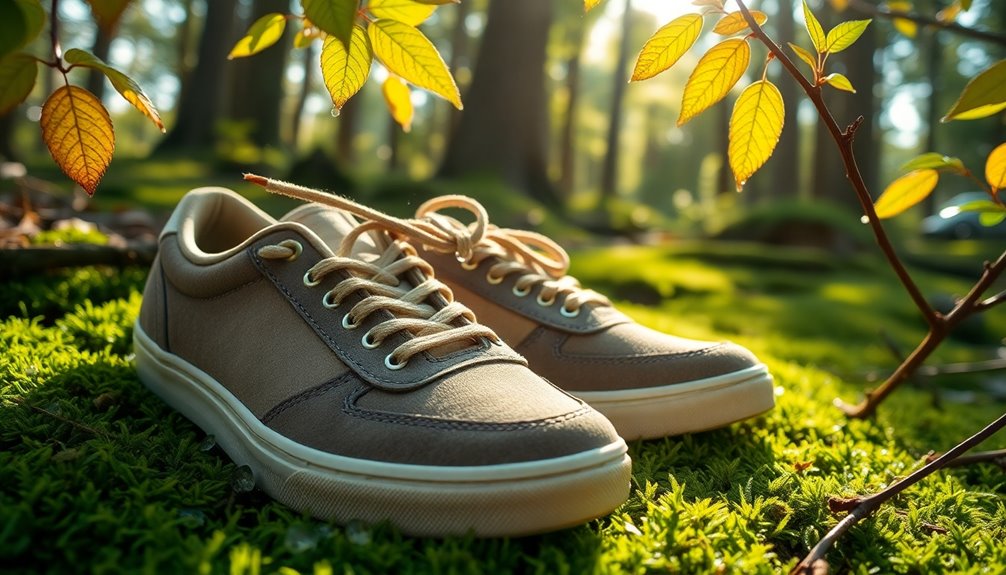
Have you ever wondered how footwear is becoming more sustainable? It starts with the materials. Organic cotton is grown without synthetic chemicals, protecting soil health. Hemp grows quickly, needs less water, and is highly durable, making it an eco-friendly choice. Bamboo fibers are renewable, soft, and often used in shoe fabrics and insoles. Ethically sourced wool offers a biodegradable, temperature-regulating option. Tencel or Lyocell, made from sustainably harvested wood pulp, uses a closed-loop process that reduces waste and water use. Recycled rubber from old tires cuts landfill waste, while recycled polyester, made from plastic bottles, helps keep plastics out of oceans. Plant-based alternatives like pineapple leaf fibers (Piñatex), cork, and mushroom leather provide cruelty-free, biodegradable options that minimize environmental impact. Incorporating space-saving manufacturing techniques can further reduce energy consumption and waste during production.
Sustainable Manufacturing Techniques
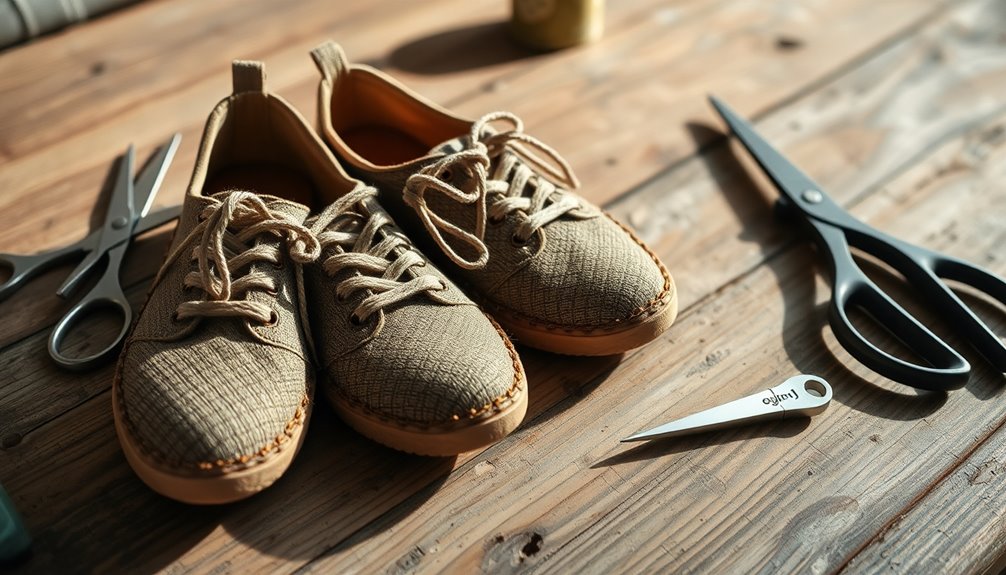
Building on the use of sustainable materials, manufacturers are adopting innovative techniques to make footwear production even greener. Manual cutting and CAD technology optimize pattern placement, reducing material waste and offcuts. Recycled content in inputs lessens the need for virgin resources, while precise assembly techniques cut defect rates and scrap. Lean manufacturing principles help prevent overproduction and excess inventory. Advanced technologies like 3D knitting create seamless uppers, minimizing waste and stitching, and laser cutting ensures high precision with less material use. Digital printing cuts water and ink waste, and automated machines boost efficiency. Additionally, biodegradable components like natural rubber and plant-based polymers, along with eco-friendly adhesives, promote end-of-life sustainability. Implementing waste reduction strategies further enhances environmental benefits throughout manufacturing, making shoes more eco-friendly from start to finish. Incorporating sustainable manufacturing practices can also significantly reduce the carbon footprint of footwear production, supported by innovative techniques that optimize resource efficiency and reduce environmental impact.
Designing for Longevity and Circular Use
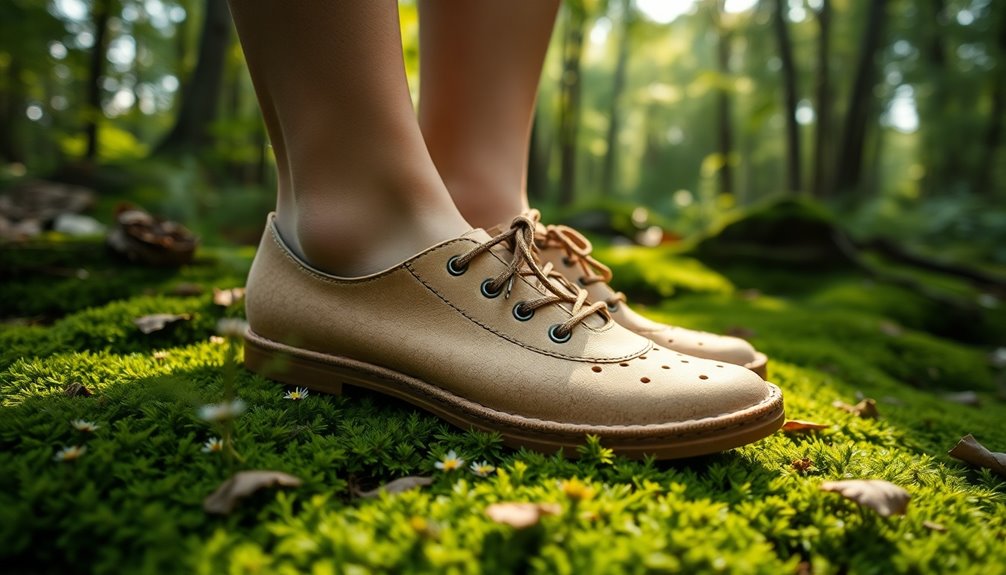
Designing shoes for longevity and circular use focuses on creating durable, timeless products that can be easily repaired or recycled. You should choose high-quality, durable materials like natural rubber, cork, hemp, or recycled plastics that resist wear and tear. Opt for classic designs that stay stylish over time, reducing the need for frequent replacements. Well-constructed shoes with strong stitching and repair-friendly features ensure they last longer. Incorporate recyclability into your designs by using materials that can be reclaimed or repurposed. Take-back programs, refurbishment services, and biodegradable options further support circular use. Educate consumers on proper care and end-of-life choices to maximize lifespan and reduce waste. Additionally, integrating AI security measures into your supply chain can help protect sensitive data and optimize logistics, enhancing overall sustainability efforts. By prioritizing durability and recyclability, you help create shoes that are both sustainable and meaningful, and considering supply chain transparency can further boost consumer trust and environmental responsibility. Implementing life cycle assessments allows designers to evaluate environmental impacts at each stage, promoting continuous improvement.
Benefits for Health and Foot Comfort
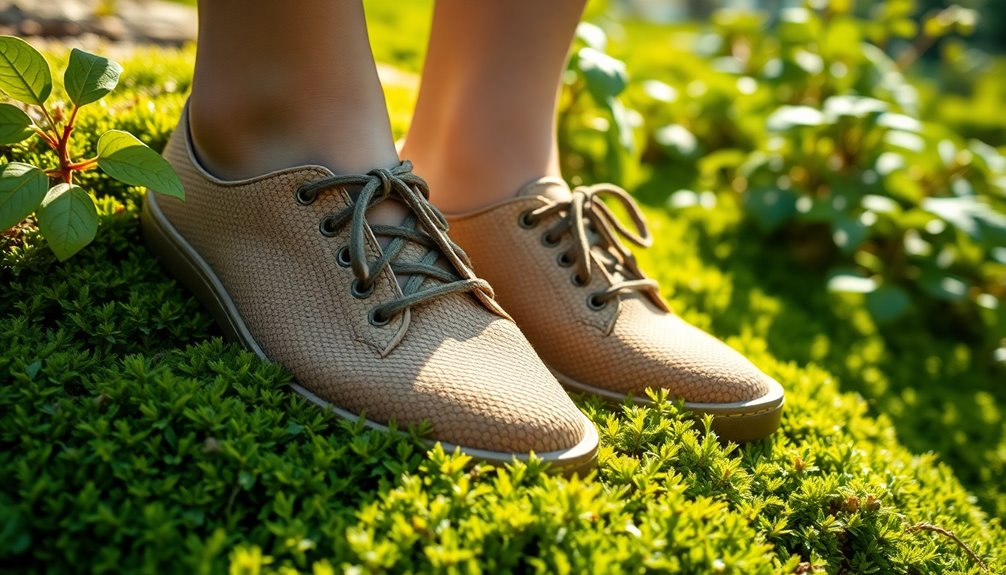
Eco-friendly shoes offer significant benefits for your health and foot comfort by using non-toxic, natural materials that minimize exposure to harmful chemicals. These shoes promote better air flow, reducing moisture and preventing issues like fungal infections. Natural materials such as wool help regulate foot temperature, keeping your feet warm in winter and cool in summer. They also provide a softer, more comfortable feel against your skin. Many sustainable shoes improve biomechanics, encouraging natural foot movement and alignment, which reduces common foot problems. Features like extra wiggle room and a natural fit support your toes and enhance overall comfort. Additionally, lightweight designs make walking easier, and better support ensures you stay comfortable throughout the day. Foot health can also be improved through the use of sustainable footwear, which aligns with ergonomic principles. Choosing shoes made from biodegradable materials helps reduce environmental impact and supports sustainable practices. Incorporating sustainable design principles further enhances both the environmental benefits and the comfort of footwear. Sustainable footwear often utilizes natural, breathable fabrics, which contribute to better moisture management and overall foot health. These fabrics can help prevent moisture buildup, reducing the risk of fungal and bacterial issues. Overall, sustainable footwear promotes healthier, happier feet.
Innovations Leading the Future of Green Shoes
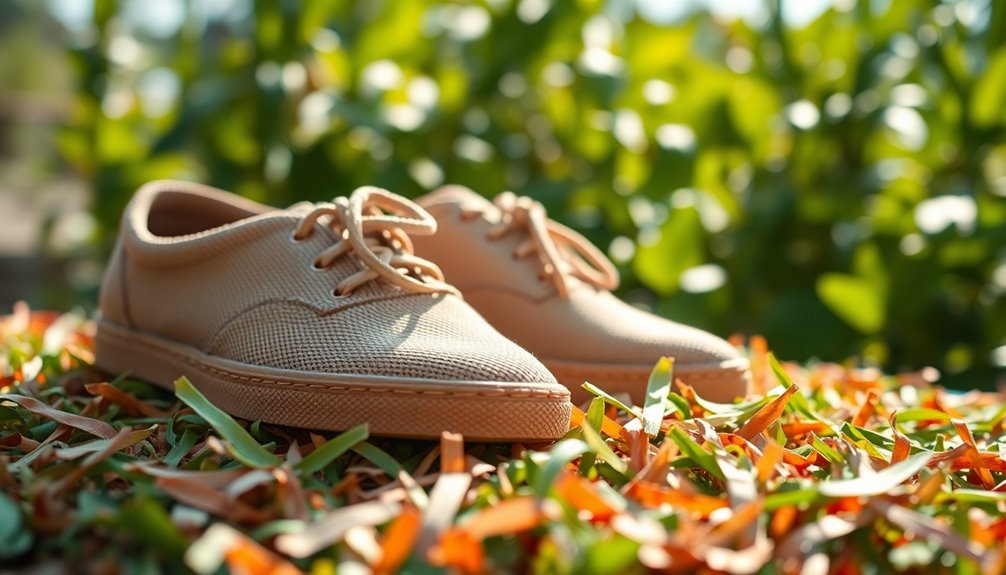
Innovations are transforming the future of green shoes by integrating cutting-edge materials and sustainable practices. For example, M0.0NSHOT Zero is the first net-zero carbon shoe made with regenerative wool that sequesters carbon and improves soil health. This shift toward regenerative fibers marks a move from merely reducing impact to actively healing the planet. Brands like Veja and Thousand Fell promote circularity by using recycled materials and establishing recycling programs that reduce landfill waste. Limited editions, such as the 500-pair run of M0.0NSHOT Zero, emphasize quality and sustainability, encouraging conscious consumption. Additionally, integrating ancient farming techniques with modern innovation helps produce raw materials that boost biodiversity and lower environmental footprints. Exploring natural fiber sourcing and tools demonstrates how innovative approaches to natural materials can further support eco-friendly practices in various industries. The development of biodegradable and renewable materials is also crucial for advancing sustainable footwear. Incorporating organic farming methods can further enhance the sustainability of raw material production, ensuring healthier ecosystems and more resilient supply chains. These breakthroughs signal a future where sustainability and innovation go hand in hand, reshaping the environmental impact of the footwear industry.
Frequently Asked Questions
How Do Eco-Friendly Shoes Compare in Price to Conventional Footwear?
You’ll find that eco-friendly shoes generally cost more than conventional footwear. On average, they’re about 70% pricier, with prices ranging from $97 to $199 compared to $111 for regular shoes. While the upfront cost is higher due to sustainable materials and ethical practices, they last longer—up to 5 years—making them more cost-effective over time. This makes eco-friendly shoes a smart choice if you value durability and environmental impact.
Are Sustainable Shoes as Durable as Traditional Options?
You might wonder if sustainable shoes last as long as traditional ones. The good news is, they often do. Eco-friendly shoes are designed with durable, high-quality materials like reinforced stitching and recycled rubber, making them comparable in lifespan—typically 3-5 years. Plus, their performance in various conditions proves they’re just as rugged, and many consumers find they need fewer replacements, reducing waste and saving you money over time.
Can Sustainable Footwear Be Stylish and Trendy?
You might think sustainable shoes are boring, but they’re actually more stylish and trendy than ever. Designers are blending eco-friendly materials like recycled polyester, natural rubber, and vegan options with high-end aesthetics. Celebrities wear them, and brands create versatile, fashionable styles. So, your eco-conscious choices can definitely keep you looking chic and on-trend. Sustainable footwear proves that caring for the planet doesn’t mean sacrificing style—it’s a win-win!
What Certifications Indicate a Shoe’s Eco-Friendliness?
You want to know what certifications show a shoe’s eco-friendliness. Certifications like the Global Recycled Standard prove the shoe contains recycled materials, while FSC Certified guarantees responsible sourcing of wood-based components. The Cradle to Cradle certification indicates eco-friendly design for recycling or composting. Bluesign emphasizes sustainable production, and Fair Trade guarantees fair labor practices. These certifications help you identify shoes that prioritize environmental health and social responsibility.
How Can Consumers Identify Genuinely Sustainable Shoe Brands?
You can identify genuinely sustainable shoe brands by checking their transparency about material sourcing and manufacturing. Look for certifications like GOTS, Bluesign, or B Corp, which indicate high environmental and social standards. Prioritize brands that use recycled or plant-based materials, produce locally to reduce emissions, and promote fair labor practices. If they openly share their supply chain details and sustainability efforts, you’re likely supporting a truly eco-friendly brand.
Conclusion
By choosing eco-friendly shoes, you’re planting seeds of change that can grow into a more sustainable world. Every step you take in green footwear helps protect our planet and your well-being, turning your daily walk into a powerful act of kindness for the Earth. Remember, your choices are the roots that shape a brighter, greener future—so step confidently into a world where fashion and sustainability walk hand in hand.
